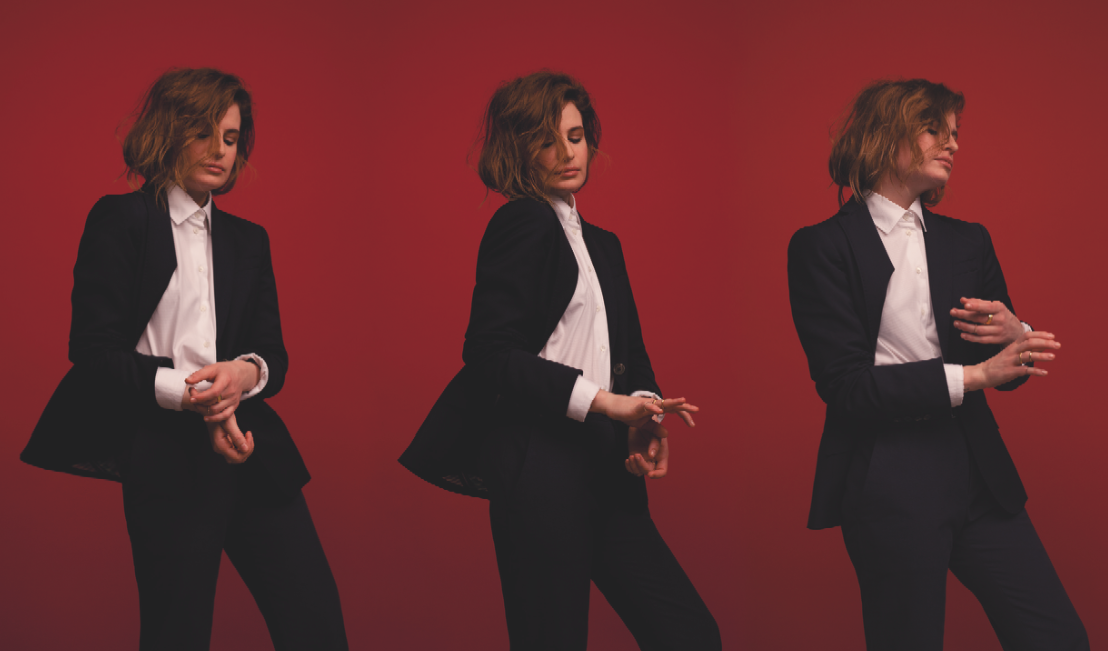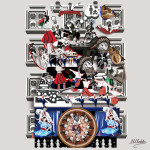“I’ve got iT/I’m a man now/And I won’t let you steal iT/I bought iT for myself/I’m a man now,” sings Nantes-born Héloïse Letissier of Christine and the Queens on the lead track of her second LP, “Chaleur Humaine,” or “Human Warmth.” She’s singing about her character becoming a man and having all of his parts but later reasserts her position as a sexually and gender curious female; in doing so she expresses her inner dialogue, the fluidity of her identity and gender the questioning of her own identity and sexuality. Ever since an otherworldly, stick thin, David Bowie all cut glass cheek bones and feminine features, draped his arm over his guitarist Mich Ronson on Top of the Pops and proclaimed that he had ‘slept with men and women’ and created Ziggy Stardust, androgyny has played a role in pop. A post-punk Siouxie Sioux‘s starkly harsh asexual mechanoid look of electric shock hair and dark make-up in the late ’70s took ownership of femininity to express an anger, subversion and difference; in the 1980s when Boy George first appeared in make-up, flamboyant clothing and long hair on television, people asked whether ‘he was a man or a woman?’ while Grace Jones was as a unique artist who embodied the different fierce gender ambiguity of artists that would follow in her waake, gender ambiguity has been represented in pop music through trailblazers who challenged the traditional and often highly sexualised, male or female orthodoxies and rampant misogyny of the music world.
Today’s artists such as Lady Gaga, Miley Cyrus, Janelle Monae, Antony Hegarty, Patrick Wolf, Perfume Genius, iamamiwhoami, Savages, Grimes, and many others continue to play and reshape perceptions of their gender and sexuality. Whilst for some it may be part of the character they play or a theatrical expression of their rejection of traditional masculine looks to subvert and make a point of their outsider status (eyeliner as an expression of sensitivity for Robert Smith for example), for others its representative of their artistic and sexual discovery. Christine and the Queens is the latest example and her work has echoes that reverberate back through pop’s multicolored, at times sexually ambiguous history that chimes with the lives of its fandom.
A self-proclaimed ‘pansexual’ (not limited in sexual choice with regard to biological sex, gender or gender identity) and bilingual 27-year-old French woman, Letissier is already a big deal in France, her superb album “Chaleur Humaine” has been re-translated and recently released for an eager English audience. Christine is a character, the Queens are a reference to the ones she met during her time at Madame Jo Jos in London during 2010. She is a veracious postmodern pop artist whose shifting sounds sound thoroughly modern, vital and questioning, keeping the listener off guard and constantly beguiled. In her live performances, her movements and songs are designed to reflect their both the masculine and feminine sides of their lives back to them on stage.
Like Ziggy Stardust or Lady Gaga before her, Christine is very much a character, one from which she draws strength and expresses difference allowing her to break free from the orthodoxy of manufactured pop princess. Letissier is recreating her birth identity in an attempt to challenge gender roles, both male and female: “The more I go with this character, the more I want to be masculine,” She told NYMag late last year “I wish I could stop putting any makeup on, start having muscles. I’m interested in transformation. It started as Klaus Nomi, and now it’s a bit more, I don’t know, Bruce Springsteen: white T-shirts, muscles. Klaus Nomi isn’t really androgynous but extraterrestrial. I’m even interested in freaks and monsters, and people who just became creatures at some point. I probably wouldn’t go the whole way like they did, but I’m interested in this obsession with reinventing yourself and even choosing your own face. I wouldn’t go into surgery because I’m afraid of it, but I’m fascinated.”
Lead single ‘Tilted’ – a song that celebrates being different, all popping minimal percussion, pulsing synth lines that caress and prod, her vocals switching seamlessly from Francois to English, and to a childlike rap, breathy oohs and ahs in some regards the sounds of sexual ecstasy re-appropriated as powerful punctuation points. Like early Lykke Li being filtered through the imagination of a Michael Jackson fan, (he was the ultimate sexually ambiguous and reconstructed, self-styled king of pop who along with Prince took androgyny mainstream in the 1980s), their mysterious neither boy nor girl looks and formidable talent often making men want to be them, girls want to be them). In the memorable video she is dressed in a masculine Dior Homme suit, her hair cut to a bob – she looks boyish: her dance style put together with choreographer Martion Motin is all straight lines, and the moves are stylised angles not sexualised poses, representative of Indian traditions each hand movement expresses power and expression. In the middle part she sings of gender duality in French:
Nous et la man on est de sortie – Us and the man are out there
Pire qu’une simple moitié – Worse than a simple other half
On compte à demi-demi – We count as half & half
It’s not a new phenomenon, of course, there are strong echoes of everything from Eurythmics Annie Lennox‘s look in the Sweet Dreams video, her red cropped hair and fierce businesswoman suit and pounding on the desk as a signal of power in a male-dominated world.
Madonna played with gender roles in the ’80s and ’90s; here’s what a study of Madonna and Queer theory notes: “Madonna’s sexual politics is female empowerment and the freedom to express female sexuality. She communicates this by taking on a ‘butch’ role in the sense that she re-appropriates the mechanisms used to control women.”
So Letissier’s suits, non-conformist movements have clear parallels with Madonna’s reassembling of sexual politics, female empowerment and the freedom to express female sexuality. She communicates this by taking on a ‘butch’ role in the sense that she re-appropriates the mechanisms used to control women. Her suits, non-conformist movement: Madonna’s constant flipping of gender roles, on stage particularly during her Blonde Ambition Tour, “Madonna performed sexual acts on her male dancers, taking the ‘top’ position which, in the traditional sense, is a male reserve.” – in this way, she subverted the male gaze, which is something Christine also does.
But while Madonna may have played the role of sexually ambiguous female with her attempts to shock audiences, such as her Sex book, or that kiss with Britney Spears at an American awards ceremony, we are aware she is still heterosexual. This was often the common misconception of androgyny it doesn’t always relate to someone’s sexuality or whether a person wishes to become transgender: and there are other clear examples of LGBT role models in pop too.
‘Jonathan’ featuring Perfume Genius, a homosexual pop star in his own right, is a bubbling lament that becomes a tale of gay emancipation and mistreatment by a partner who never provided closure.
“Klaus Nomi chose to be supernatural, Perfume Genius chose to stare right back at you, smoking a cigarette with his nails polished, and as for me, I tried my best to make all my wounds pop. It’s all about being loud and fierce – shame is nothing but an insidious negation: you shrink, you whisper, you hide. Shame is something queer culture still fights today, with new words, new ways of existing.
I wrote Jonathan because my lover would ignore my existence outside of the closed, silent room I lived in; it became then imperious for me to sing, just to make sure I was still here. From the start, the song had two voices; one in English, one in French – longing for an answer I knew I would never get. So it was there, on my computer, crepuscular, like my own little Madame Butterfly’s swansong,” Letissier told the Guardian last year.
Its duel haunting vocals that are both male and female, it has echoes of the themes of Antony Hegarty of Antony and the Johnsons swelling piano opuses to transgender and sexuality open experiences particularly I Am a Bird Now single ‘You are My Sister’ – a touching duet with Boy George that became a anthem for the lesbian, gay, bisexual and transgender communities. More than androgynous, he is the first openly transgender pop star Antony Hegarty’s sexuality and gender has been much written about: a man who sings in a heart-stopping falsetto that could be mistaken for a woman’s voice; transgender is still a taboo for many in Western culture: “I prefer [the transgender] label to “gay,” says Antony. “Listen, I believe that we all contain a family within us: a mother, a father, a son, a daughter. As far as how it affects my music, I think it’s the same as in the case of being an immigrant. When you are outside the norm, it tends to make you more introspective.”
“I wrote that song about my (biological) sister,” he says. “Bringing George in, it became layered with all this other meaning related more to my community experience. But then it’s just sort of opened and opened and opened.”
More starkly, Miley Cyrus‘s transformation from family-friendly Disney teen star to platinum-haired, red lipstick painted, boyish waif wielding a sledge hammer on her single ‘Wrecking Ball’ was a not so subtle reference to the butch lesbian look the stark brutal imagery. “All I wanted was to break your walls/All you ever did was break me,” as she is, plays the role of both victim and revenge taker in the memorable video, although we may question her need to be almost naked to make the point and in turn playing to the male gaze whether she intended to or not?
Letissier’s style is more subtle and theatrical but musically, in my view, carries more weight and depth, more sophisticated, artful and nuanced her splicing of musical styles, her bilingual abilities giving the songs constantly fresh perspectives: her tales of identity and gender are ambiguous yet universal to human experience.The R&B pops of ‘No Harm Is Done’ is counterbalanced by a male rap from Tunji Ige, framed by neon, Letissier presents like a slightly butch yoga teacher with muscles, like the teacher orchestrating her male dancers in a multi cultural slice of universal genre-hopping pop music.
“He’s my station,” sings Letissier on the outstanding ‘Saint Claude’ – the title perhaps a reference to a lover? A saint who gives her comfort? Who knows… The videos expressive dance moves and exultant choruses are effecting and addictive, sultry yet wounded and lonely “we are so lonely in this part of town,” she opines as she dances in slow motion, surfing that place that Michael Jackson occupied with his moves both expressive and gently instructive of modern dance and ballet at others crotch thrusting, sexually suggestive and referencing street-dance.
Shirley Manson once sang, “You free your mind in your androgyny,” and with technological and aesthetic advances of the ’00s, Letissier is part of a post-feminist movement that has been named ‘genderqueer’, its representative of a less aesthetic and theatrical androgyny and more of the psychological freeing of the shackles of gender and sexual binaries: as society has become slightly more relaxed about issues surrounding gender and sexual orientation, artists have continued to express their refusal to be placed into gender boxes, and talked of a more complex internal dialogue and less binary world experience. Acts like Shamir, MEN and most notably, one of the most unique pop artists of our times Claire Boucher’s Grimes embodies this genderqueer strand with her ever-shifting neon alien, multi cultural look, that embodies elements of masculine and feminine, trying on and rejecting them in turn and refusing to let her multicolored bricolage of futuristic music(as typified in last years ‘Art Angels’ album) sounds be pigeonholed or defined by her gender, after all, gender is not a genre in music is it?
Janelle Monae whose retro suits, bow-tie and afro bun are boyish yet fiercely representative of a confident female empowerment that chimes with post Beyonce pop culture. That she doesn’t identify with any sexuality responding to questions about her sexuality with the mysterious: ‘I loved an android’ makes her symptomatic of the new guard of less willing to be pigeonholed female pop stars, after all, her excellently smart R&B influenced sound (such as ‘Tightrope’ below) has been what has made her an icon of modern pop performance.
Christine and The Queens craft special pop music that’s reflective of the roles we play, of societies norms we try to fit into and fight, the faces we put on the description associated with appearing to not fit neatly into them. As Virginia Woolf put it, androgynous duality is present in work of the best writers and artists: “woman-manly or man-womanly… Some collaboration has to take place in the mind between the woman and the man before the art of creation can be accomplished. Some marriage of opposites has to be consummated.” I think it’s one of the best albums I have heard so far this year and reflective of the spectrums of gender identity and sexuality in 2016 and where we all sit on it.
References and Further reading:
http://www.theory.org.uk/madonna.htm
http://www.clashmusic.com/features/prove-it-on-me-androgyny-in-music
http://www.dazeddigital.com/music/article/24824/1/how-pop-is-starting-a-genderqueer-dialogue




